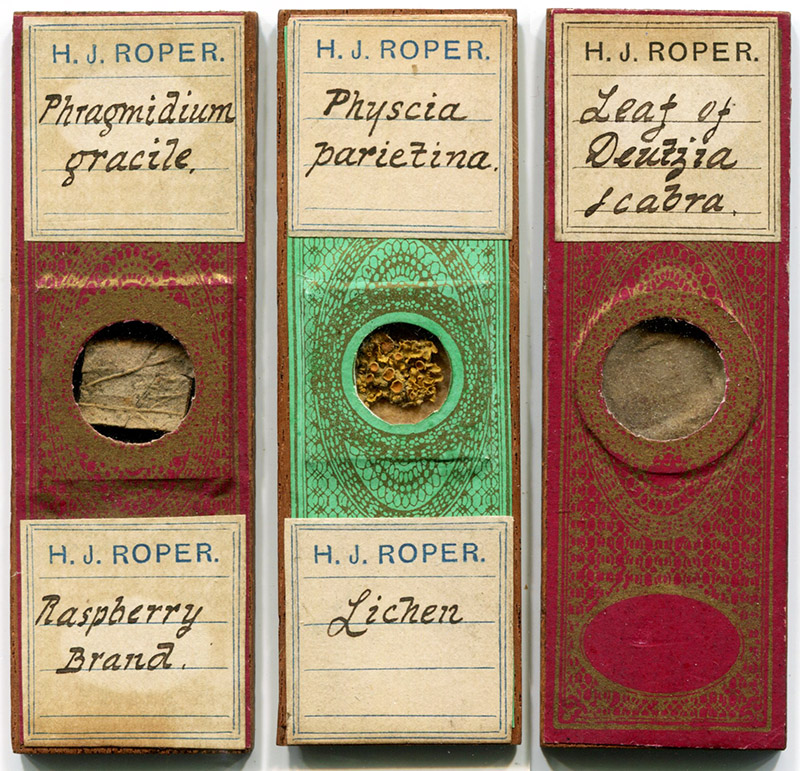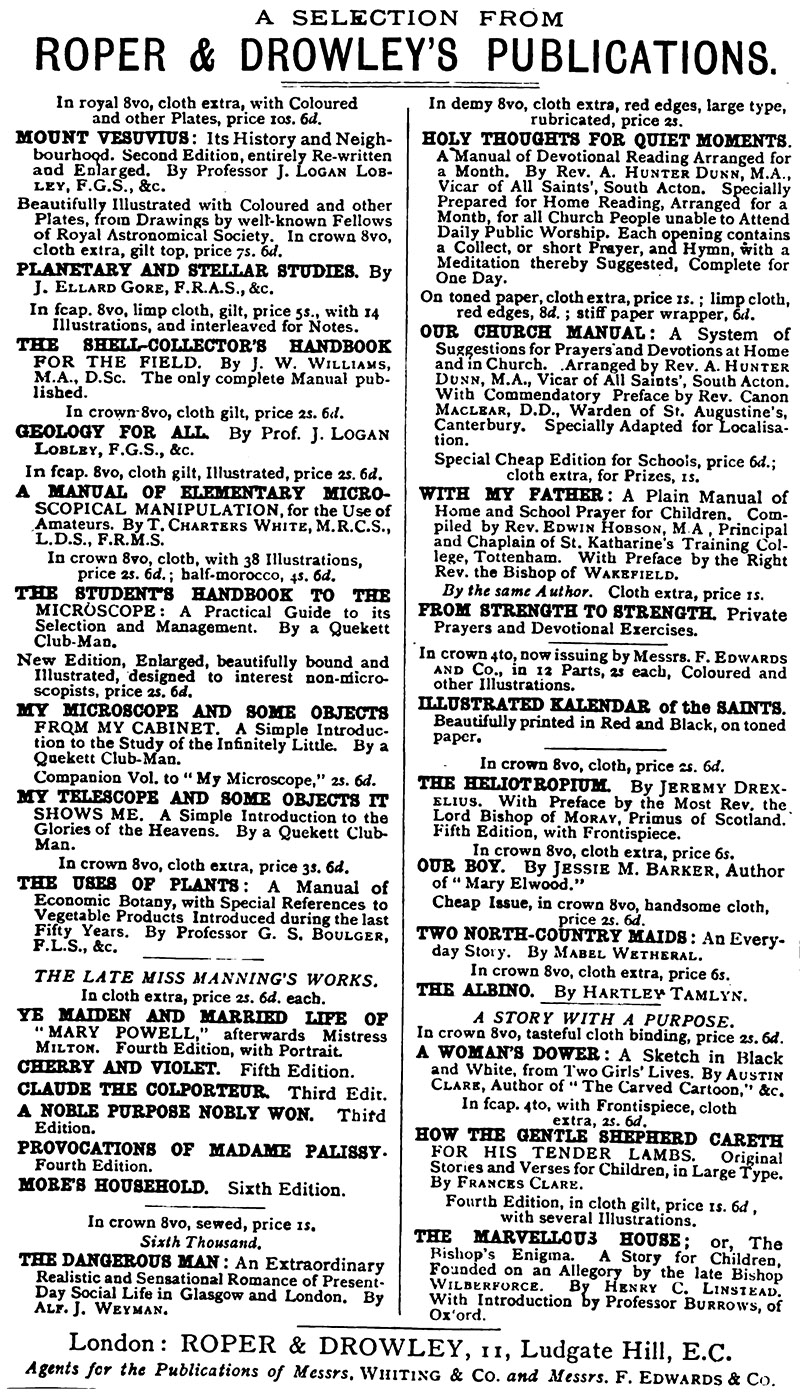
Figure 1. Microscope slides by H.J. Roper. All are dry-mounts on wooden slips, presumably produced using the method that he described in 1880 (see below).
Henry John Roper, ca. 1846 - 1908
by Brian Stevenson
last updated July, 2019
Henry Roper had become an enthusiastic microscopist by the mid-1870s. He joined the Quekett Microscopical Club in 1876, and the Royal Microscopical Society in 1877. Judging from the many specimens that he exhibited to club colleagues, and his surviving slides (Figure 1), Roper’s main microscopical interests were fungi, lichens, and botanical objects. He made a substantial contribution to the preparation of microscopical specimens in 1880, with publication of his method for mounting botanical tissues (reprinted below). Importantly, Roper recommended that plant tissues be mounted on wooden slides, rather than glass, to avoid condensation on the cover slip.
Roper cancelled his membership in the QMC during the late 1880s. That coincided with a major change in his occupation, which may have encroached on his free time. Previously, Roper had been a clerk for a publisher. In 1887, he opened his own publishing company. I did not find evidence of Roper returning to microscopy after that date. Thus, we can reasonably date H.J. Roper’s production of microscope slides from the early 1870s until ca. 1887.

Figure 1.
Microscope slides by H.J. Roper. All are dry-mounts on wooden slips, presumably produced using the method that he described in 1880 (see below).
Henry J. Roper’s method for preparing botanical microscope slides was published in The Journal of the Quekett Microscopical Club, based on his presentation to the QMC on August 27, 1880:
“On A Method Of Dry-Mounting For Opaque Objects, by Henry J. Roper, F.R.M.S.
A former President of the Club once remarked that he should like to see more papers for beginners among the work done by the members. In offering a few observations on a very easy and simple method of dry-mounting, I feel that I am, at any rate, supplying one paper of this description.
The first attempts of the possessor of a microscope at mounting objects are generally in this direction, and to speak from my own experience, are not always satisfactory ; but a few hints on trifles which much practice has shown to be really essential, may prove useful to many.
The materials for mounting in the form suggested are neither many, expensive, or complicated. A supply of mahogany slides, 8 x 1 in., with central circular cell pierced partially through the slide leaving a "floor" of the wood (these may be procured at 1s. per dozen), some square covering glass, some sheets of wax, such as is used for making wax flowers, which cost, I believe, 1s. 6d. per dozen small sheets (green and white are perhaps the most useful colours, black is not made), and some covering papers of the ordinary kind; when some name labels are added, the whole of the necessaries are to hand, except a penknife, which everyone carries in his pocket.
To mount any easy opaque object - for example, a portion of leaf with a parasitic fungus on it - first cut a square, say about an inch across, of the green wax, and lay it over the aperture in the slide; press it firmly down, and it will line the whole cell smoothly, and leave a margin of wax projecting all round the upper surface of the slide; having made sure that the leaf has no foreign matter on it, cut it so as to nicely fit the sunken cell, now lined with wax, if preferred leaving the wax showing all round, and a very slight pressure with the forefinger will ensure its adherence to the floor of wax, without in any way damaging the leaf or fungus; now take a clean covering glass, place it over the wax cell containing the object, and press it firmly but gently down, then remove with the penknife all superfluous wax close to the edges of the covering glass; place over this the covering paper, not applying too much moisture round the central aperture, and the slide is complete, and can be labelled and placed in the cabinet at once.
It will sometimes happen that a slide is bored so deeply that it is necessary for the convenient illumination of the object, that something more than one thickness of wax should be placed in the cell, so as to bring the object nearer to the covering glass ;this can be taken advantage of to produce a very pretty effect. Before proceeding to line the cell with the wax, place an ordinary wafer in the bottom of it, moistening only the lower surface, choosing one, say, of a deep red colour; place over this a square of the white wax, which is always semi-transparent, and the result will be a delicate pink ground, well calculated to show up to advantage many opaque objects; other coloured wafers will produce at pleasure grounds of different tints, quite destitute of ‘glare’ or ‘reflection’, and ‘soft’ and pleasing to the eye.
The advantages of this method, which is not new, except in slight but not unimportant modifications, are the unfailing certainty of the process, its celerity, total independence of turntables and varnishes, the lightness of the slides, the non-liability to breakage (for there is nothing frangible but the covering glass), and last, but not least, the permanence of the preparation.
I see that an American professor is discarding a somewhat similar method on account of, as he says, ‘the covering glass, sooner or later, becoming covered inside with a dew-like deposit, which, when illuminated, will glisten like so many minute points of quicksilver’. I have myself noticed this occasionally in specimens mounted something in this style, on glass slides, but very rarely (not perhaps one per cent.) when mounted on wooden ones; and then no doubt the wax was used when too new, sufficient time not having been allowed for its volatile properties to evaporate; it is probable, too, that the wood itself may absorb the slight moisture which, in the case of the glass, can obtain no other refuge than the covering glass; at any rate, speaking from one's own experience, I have found no inconvenience on this score, after mounting many hundreds of slides, extending over several years.
�������������������������The result of this very simple, quick, and easy process is, that the object is enclosed in a cell at once air-tight and water-tight, the adhesion of the wax to the wood, and the covering glass to the wax, strengthened by the adhesive cover paper, ensuring immunity from damp, while I have never known an instance in which any object was in the least affected by contact with the wax itself.
_________________________________________________________
Census records indicate that Henry Roper was born in about 1846 in Manchester, England. I did not find a record of his birth, however. Records of the 1851 and 1861 censuses, when Henry was 6 and 16 years old, respectively, show him as living in Oxford with Isabella Sandell, an unmarried school mistress who was about 26 years older than Henry. Roper was the only person who lived with Sandell, implying a special relationship.
Roper’s parentage is also uncertain. His 1872 marriage record listed his father as “Henry John Roper, Clerk in Holy Orders”. I have not found further records of a person with that name. There was, however, a well-known Congregationalist minister named Henry Isaac Roper, born ca. 1806. Noting that our microscopist was not raised with his father, and that the father did not witness his son’s marriage, it is possible that our man mis-recalled his father’s middle name.
By 1871, Henry had moved to Peckham, Surrey, and was working as a “publisher’s clerk”. He married in 1872. His wife, Mary Ann Newman, was from Oxford, and was presumably a childhood sweetheart.
Henry was elected to membership in the Quekett Microscopical Club on June 23, 1876. He became a Fellow of the Royal Microscopical Society the next year. For the next several years, both The Journal of the Quekett Microscopical Club and The Journal of the Royal Microscopical Society listed numerous records of Roper displaying preparations of fungi and botanical specimens. He also published requests in popular scientific magazines to exchange specimens (Figure 2).
In 1887, Roper left his previous employer and began his own publishing company. The Printing Times and Lithographer reported, “Mr. H.J. Roper and Mr. J. Drowley, both for many years with Mr. Elliot Stock, of Paternoster-row, have commenced business as publishers at St. Martin’s House, 29, Ludgate-hill. The firm will trade as Messrs. Roper & Drowley”. The business published scientific works such as the microscopy classic My Microscope and Some Objects from My Cabinet, by “A Quekett Club-Man” (nom-de-plume of T. Charters White), and popular fiction such as Mrs. Senior Junior, by Foulis Hayes (a review read: “Persons in search of a sensation of a new and peculiar kind may find it if they wish in Mr. Hayes’ novel. There is an extraordinary ‘secret’ involved in the story which, of course, eventually is revealed in its full proportions. Clandestine marriages are common enough, and fraudulent weddings performed by sham clergymen are no novelty. But it will be confessed, that for a man to marry a wife and only discover her sex at the end of two years, is rather a startling affair. Yet this is the awful secret that underlies the tale. ‘I turned the handle and stepped into Linda’s room. Reflected in a mirror on the opposite wall I saw, ere I could retreat, my wife like a dripping Naiad rise gracefully from her bath. Great God! I quietly closed the door and stumbled into the lobby. My wife, Mrs. Senior Junior, was a man!’ ”).
Roper quit his membership in the QMC at this same time. Operating his own business probably occupied a large part of Henry’s time and money.
Roper and Drowley merged with another publisher, R. Sutton & Co., in 1890, forming Sutton, Drowley, & Co. Presumably, Roper remained as a partner with the new business: the 1901 census listed his occupation as “bookseller & manager”. The Ropers then employed a domestic servant. Henry died on August 2, 1908.

Figure 2.
1880 exchange offers by H.J. Roper, from “Hardwicke’s Science-Gossip”.

Figure 3.
A listing of some of the books that were published by H.J. Roper’s business in 1888, from “British Books in Print”.
Resources
Bookseller (1889) Reviews of books by Roper and Drowley, page 79
British Books in Print (1888) Advertisement from Roper and Drowley, Vol. 5
England census and other records, accessed though ancestry.com
The Journal of the Quekett Microscopical Club (1876) “Ordinary Meeting: June 23rd, 1876 … The following gentlemen were balloted for, and duly elected members of the Club: - Mr. Addis, Mr. Chas. Allison, Mr. Jas. Bowles, Mr. Wm. S. How, Mr. T.R. Johnson, Mr. Thos. E. Jones, Mr. Chas J. Kindon, Mr. H.S. Lerson, Mr. Rd. G. Pearcy, Mr. John T. Redmayne, Mr. Henry J. Roper, and Mr. Jas. W. Wills”, Vol. 4, page 201
Journal of the Royal Microscopical Society (1879) “Ordinary Fellows … 1877, Roper, Henry John. 5, Lausanne-road, Peckham, S.E.”, Vol. 2, page lv
Hardwicke’s Science-Gossip (1880) Exchange offers from H.J. Roper, Vol. 16, ages 168 and 216
Marriage record of Henry John Roper and Mary Ann Newman (1872) Parish records of St. Giles, Oxford, accessed through ancestry.com
Printing Times and Lithographer (1887) New series, Vol. 13, page 37
Probate of the will of Henry Roper (1908) “Roper Henry John of 29 Abdale-road Shepherds Bush Middlesex died 2 August 1908 at St. George’s Hospital Middlesex Probate London 22 August to Mary Ann Roper widow. Effects £168 15s”, accessed through ancestry.com
Roper, Henry J. (1880) On a method of dry-mounting opaque objects, Journal of the Quekett Microscopical Club, Vol. 6, pages 193-195